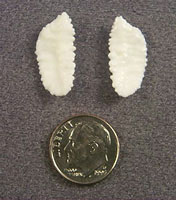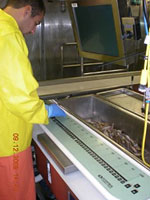

 | |||||||||||
|
|
Journals 2009/2010Beth Brocato
September 13, 2009 Coordinates: Track the Bigelow. My alarm wakes me up...is it really 9 p.m.? Time to get up and get ready for our second day of trawling. The sorting machinery and data collection software on this ship are really high-tech. Once a tow net is opened up, the catch flows down a series of conveyor belts. It is our first job to sort similar species into buckets.
Once the species are sorted, we work in 2-person teams. Each team takes a species to collect data. One person is called the "cutter" it is their job to measure, weigh, open the stomach to look for stomach contents, and to dig out the otoliths. The otoliths are the fish's ear bones and are used to determine the age of the fish.
The other person is the recorder. They stack the fish for the cutter and use the data collection software to collect information about each fish. Once a team has completed data collection for one species, they start on another until the entire catch has been catalogued. QUESTION: What are otoliths?  |
||||||||||

